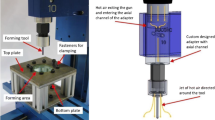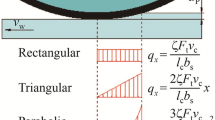Abstract
The present study aims to numerically analyze the surface temperature uniformity of the multi-zone/single-zone ceramic heaters because the temperature uniformity becomes important in the semiconductor process, in close association with increasing productivity, depending on the power of heaters and the coolant temperature. The extensive simulations were conducted by the commercial code of ANSYS Fluent (V.2020.R2). It was found that the maximum temperature differences between the center of the puck and edge were estimated to be 32 K and 25 K for the circle and ring-type single-zone heaters, respectively. Also, the temperature difference between the center of the puck and the edge increased with the power of the ceramic heater. When using the multi-zone heater, a temperature difference was predicted to be 4.73 K, showing a smaller variation in space. It is concluded that the multi-zone heater can yield a more uniform temperature field in the radial direction.
Similar content being viewed by others
References
J. Li, T. Luo, H. Wen, J. Deng, M. Wu, Y. Li, G. Wang and Y. Pei, Design and regularity research of MOCVD heating plate based on experiments and simulations, Vacuum, 174 (2020) 109174.
H. K. Oh, S. B. Kang, Y. K. Choi and J. S. Lee, Optimization of rapid thermal processing for uniform temperature distribution on wafer surface, Journal of Mechanical Science and Technology, 23(6) (2009) 1544–1552.
M. Blauw, P. Van Lankvelt, F. Roozeboom, M. van de Sanden and W. Kessels, High-rate anisotropic silicon etching with the expanding thermal plasma technique, Electrochemical and Solid State Letters, 10(10) (2007) H309.
T. K. Lim and S. H. Rhi, Experimental study on nanofludic heat pipe hot chuck plate in semiconductor wafer baking process, Journal of Mechanical Science and Technology, 24(7) (2010) 1501–1509.
Y. D. Lim, D. Y. Lee, W. J. Yoo, H. S. Ko and S.-H. Lee, Temperature of a semiconducting substrate exposed to an inductively coupled plasma, Journal of the Korean Physical Society, 59(2) (2011) 262–270.
D. Tretheway and E. S. Aydil, Modeling of heat transport and wafer heating effects during plasma etching, Journal of the Electrochemical Society, 143(11) (1996) 3674.
K. Asano, F. Hatakeyama and K. Yatsuzuka, Fundamental study of an electrostatic chuck for silicon wafer handling, IEEE Transactions on Industry Applications, 38(3) (2002) 840–845.
K. A. Olson, D. E. Kotecki, A. J. Ricci, S. E. Lassig and A. Husain, Characterization, modeling, and design of an electrostatic chuck with improved wafer temperature uniformity, Review of Scientific Instruments, 66(2) (1995) 1108–1114.
T. Watanabe, T. Kitabayashi and C. Nakayama, Relationship between electrical resistivity and electrostatic force of alumina electrostatic chuck, Japanese Journal of Applied Physics, 32(2R) (1993) 864.
D. L. Goodman, Effect of wafer bow on electrostatic chucking and back side gas cooling, Journal of Applied Physics, 104(12) (2008) 124902.
Y. H. Im and Y.-B. Hahn, Heat transfer between wafer and electrode in a high density plasma etcher, Korean Journal of Chemical Engineering, 19(2) (2002) 347–350.
D. R. Wright, D. C. Hartman, U. C. Sridharan, M. Kent, T. Jasinski and S. Kang, Low temperature etch chuck: modeling and experimental results of heat transfer and wafer temperature, Journal of Vacuum Science & Technology A: Vacuum, Surfaces, and Films, 10(4) (1992) 1065–1070.
O. Lucia, P. Maussion, E. J. Dede and J. M. Burdio, Induction heating technology and its applications: past developments, current technology, and future challenges, IEEE Transactions on Industrial Electronics, 61(5) (2014) 2509–2520.
T. Samir, Improving wafer temperature uniformity for etch applications, Doctoral Dissertation, Texas Tech University (2003).
D. H. Im, W. S. Min and S. J. Hong, Planar heating chuck to improve temperature uniformity of plasma processing equipment, Japanese Journal of Applied Physics, 59(SJ) (2020) SJJD01.
D. S. Woo, C. Han, B. D. Youn and K. J. Kim, Thermal modelling and design of dynamically-controlled heater plates for high temperature processing of 300 mm wafers, Journal of Mechanical Science and Technology, 33(10) (2019) 5009–5016.
H. T. Chua, A. Tay, Y. Wang and X. Wu, A heater plate assisted bake/chill system for photoresist processing in photolithography, Applied Thermal Engineering, 29(5–6) (2009) 985–997.
J. Lee, H. G. Kwon, S. Shin, S. Han, J. Ha, H. Yoo and H. H. Cho, Thermal design of hot plate for 300-mm wafer heating in post-exposure bake, Microelectronic Engineering, 88(11) (2011) 3195–3198.
A. Tay, H. T. Chua, W. Yuheng, Y. Geng and H. W. Khuen, Modeling and real-time control of multizone thermal processing system for photoresist processing, Industrial & Engineering Chemistry Research, 52(13) (2013) 4805–4814.
H. Lee, J. Ryu and S. Lee, Influence of perforated fin on flow characteristics and thermal performance in spiral finned-tube heat exchanger, Energies, 12(3) (2019) 556.
ANSYS Fluent 2020 R2 User’s Manual, ANSYS, Inc., Canonsburg, PA, USA (2020).
F. P. Incropera, D. P. DeWitt, T. L. Bergman and A. Lavine, Principles of Heat and Mass Transfer, 7th Ed., John Wiley & Sons, New Jersey, USA (2014).
Acknowledgments
This work was supported by the Chung-Ang University Graduate Research Scholarship in 2018 and the Technology Innovation Program (20011259, Development of Electrostatic Ceramic Heater including Multi-Zone Capable of Precision Temperature Control) funded by the Ministry of Trade, Industry & Energy (MOTIE, Korea).
Author information
Authors and Affiliations
Corresponding author
Additional information
Hyung Ju Lee received his B.S. and M.S. degrees from Chung-Ang University. He is currently a Ph.D. candidate in School of Mechanical Engineering at the Chung-Ang University. His research interests are visualization of phase change phenomenon and computational fluid dynamics.
Seong Hyuk Lee received his B.S., M.S., and Ph.D. in Mechanical Engineering Department from Chung-Ang University in Korea. Now, He is a Professor of Mechanical Engineering Department at Chung-Ang University. He has various research fields in heat and mass transfer: evaporation/condensation heat transfer, SPR visualization, and computational physics.
Rights and permissions
About this article
Cite this article
Lee, H.J., Lee, S.H. Numerical evaluation on surface temperature uniformity of multi-zone and single-zone ceramic heaters with the electrostatic chuck. J Mech Sci Technol 35, 3763–3770 (2021). https://doi.org/10.1007/s12206-021-0745-3
Received:
Revised:
Accepted:
Published:
Issue Date:
DOI: https://doi.org/10.1007/s12206-021-0745-3




